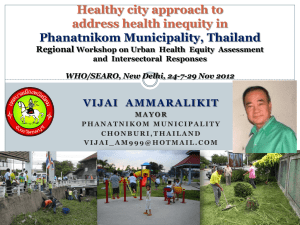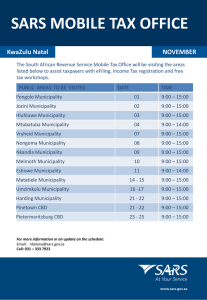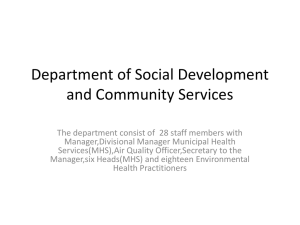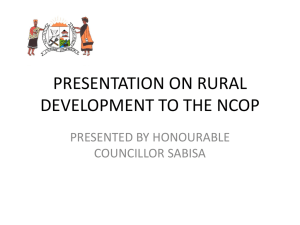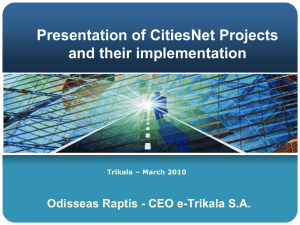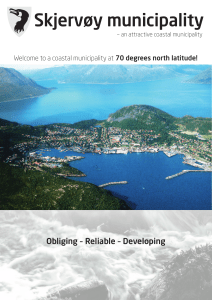Developing Industrial Parks
advertisement
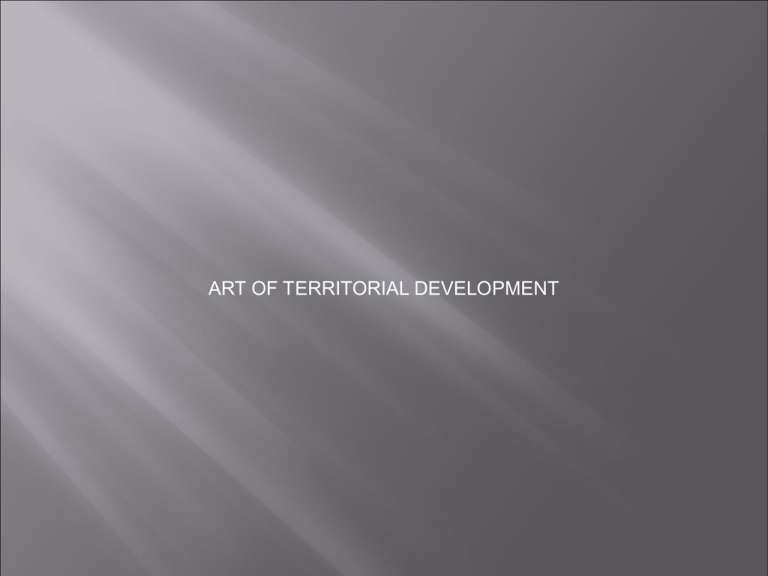
ART OF TERRITORIAL DEVELOPMENT 1. Strategic public management - strategy management practice as a critical functional competitive advantage - strategy management is: analyzing planning partnering implementing monitoring updating - national strategic planning National Strategy of Coherence National Economic Strategy National Master Plan Sectoral documents (energy security etc.) - national planning and operative documents are mostly consulted with self-governance authorities, employer’s organizations, labor unions and som major sectorial stakeholders relations between single ministries are very often difficult in terms of policy coordination (representing opposite interests) - there are field where national planning stays weak and has more meaning at the local level (municipality) 2. Planning of the regional development - Regional Strategy for Development – broad approach without specific actions (Action Plan) based on number of other specialized document and analysis - Regional Innovation Strategy as a base for actions and monitoring in the region document came out of strategic process, based on research and deep analysis, provides goals and actions the way to achieve goals and organize action is not précised incremental approach to strategy development - updating and monitoring RIS 3. Territorial investment marketing - we must agree on common marketing goals (region, LSEZ, municipality – case by case) - very often (major cases) region acts in cooperation with LSES, without municipality engagement - pro-active approach depends on individualities (marketers) - differentiation of the business today as a must textile-based economy gave us long-lasting lesson priorities regarding sectors and branches must be based on regional resources and competences depending on the scale of the region we choose amount of industries we want invest in always stay open for any business coming into region - after-sale services human resources (training, recruitment, development) business partners (example of LZES Partner Program) networking innovation promotion 4. Industrial Parks development - no legal backbone for industrial park development - establishing on the basis of company law and master spatial planning - stages: choice of public area (owned by the municipality or LSEZ) providing spatial planning that concern activities we expect establishing / choosing (if there is one in the region) plc. / ltd. company which is responsible for investment and management etc. join marketing with municipality / LSEZ / region - consolidation of land – CRITICAL ISSUES - offer preparation (example) - negotiation process (example) DEVELOPING INDUSTRIAL PARKS 1. What is industrial park? 2 approaches: - integrated geographical area where investment plots are located next to each other - diversified structure of investment locations (small plot complex) within the borders of commune / municipality 2. What is the process of developing industrial parks? - analysis of regional potential (space, activities we lack, people’s skills and competences, traditional resources) - defining sectoral strengths of specific communes / municipality - deploying concept of zoning precising what activities are allowed to be run in chosen zones - integration of land (public sector as a buyer) - providing technical infrastructure (public investment) - preparing an investment offer consisting of: oinfrastructure (investment site and its technical profile) ohuman resources (offer planned in line with sectoral strengths) ofinancial advantages (calculation of everything that can influence ROI - how we started the process: concept of SEZ 3. How do we deal with timing and pace of our development? - creation of an industrial park must be divided into number of small steps (geographic limits in terms of scale) - at the beginning we choose the most attractive locations to equip with infrastructure - after succeeding with first site we move infrastructure investments further 4. How do we take care of local / regional interest? (HINTS) -single real estate operation (selling investment site to the investor) should be combined with investor’s obligation to deliver précised parameters: ojobs created until… omoney invested until… oinvestment accomplished until… oinvestment will be in place for at least…[1] 5. Management and marketing of an industrial park - in terms of management there are three basic options to deploy: commune / municipality directly manages the park commune / municipality establish / use public-owned company / agency to business attracting private company to manage the park on the basis of contract - what is a must to manage and marked our industrial park’s offer: structure of one-stop-shop well-qualified people good branding (templated for everything) - marketing labor market offer based of real strengths open for case by case actions (schools, trainings etc.) REGION KUTNO Process: 1. 2. 3. 4. 5. Strategy of the Municipality Spatial Master Planning Buying the land Providing technical infrastructure Services for investors KUTNO Wykupy – stan na 1999 r. KUTNO Starting Industrial Park “Special Economic Zone” Kutno - 1999- 23 ha Development - 2002 2004 2005 2008 – 45 ha – 36 ha – 47 ha – 100 ha 2002 – technical infrastructure 2004 – first companies KUTNO Ul. Wschodnia – 2002 KUTNO Ul. Wschodnia – 2006 KUTNO 2008 - KUTNO 2008 KUTNO Investment sites for logistics KUTNO Kellogg, PolyOne PrintPack Fuji Seal Ideal Europe Aurora Paja Folie Sirmax Profil Pas DS Smith K UT TNO Aarsleff Kongskilde Skiold BL Kofola Tesalca Espatex Libner Trouw Nutrition Nijhof-Wassink DEVELOPING REGIONAL INFRASTRUCTURE 1. Regional self-governance in Poland - current structure of regional government was established in 1999; Poland is divided into 16 regions; - regional budget is created out of respective tax percentage (CIT, PIT), national donation, and European funds; - there are two bodies within regional self-governance: Regional Council (members elected directly every 4 years) – legislative body Board (5 members elected by the Regional Council) – executive body whish is having the Marshall Office as its administration 2. Building regional networks - the self-governance in Poland consists of 3 levels: region - policy-making, financial support for municipalities county (powiat) – administrative role (building permitting, vehicle registration etc.) municipality – direct power in terms of territorial management (master planning, real estate taxation, municipal infrastructure etc.) - depending on the specific theme regional networks have different actors for investment development we operate within municipality, Lodz Special Economic Zone Plc and regional government administrative procedures, such as building permit engage each level of self-government (region, county, municipality) 3. Regional policy - importance of specific documents: Strategy of Development for the Region of Lodz Regional Innovation Strategy Regional Operation Program Wertical and sectoral policies / programs - each strategy document is a product of public consultation (with stakeholders of specific document) - specific departments at the Marshall Office (regional administration serving to the Board for regional policy implementation 4. EU Funds implementation - regional government (administration at the Marshall Office) is currently responsible for EU implementation from Regional Operation Program - budget of 1,3 billion Euro (2007-2013) - there are two ways of selecting infrastructure project to be financed by EU funds: applying to the contest acceptance by the Board of the Region for the List of Key Projects - the importance of specific documents within regional policy planning and implementation shows how region defines priorities of EU projects -regional government (and all regional institutions) can be also a recipient of EU funds from Regional Operation Program 5. Transport, water, energy infrastructure - without basic infrastructure in place we cannot act in order to attract investment - the level of municipality is responsible for construction, maintenance and operations regarding basic infrastructure - by basic infrastructure we understand: local roads, water systems, sewage systems, - region (EU money / aimed donation) and Lodz Special Economic Zone Plc (by direct investment) can support municipality in developing infrastructure - region is responsible for regional roads, so in this way supports specific areas 6. ICT INFRASTRUCTURE - optic-fiber backbone network - connecting all municipalities in the region - outsourcing the preparation and management to the Lodz Regional Development Agency SUCCESS STORIES
